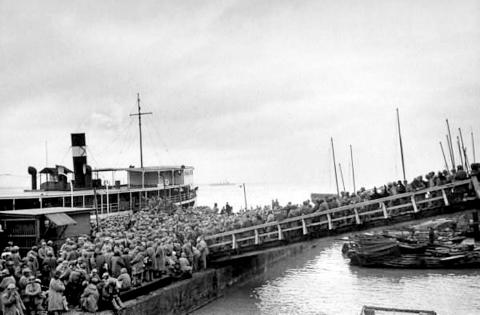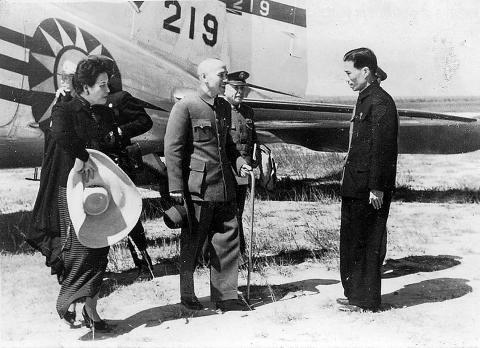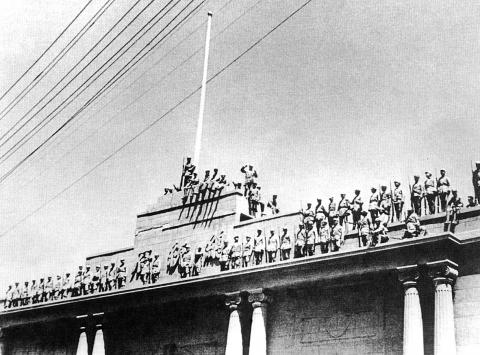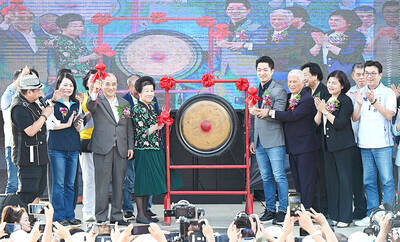Taiwan in Time: Dec. 5 to Dec. 11
Shortly after noon on Dec. 10, 1949, Chiang Kai-shek (蔣介石) and his son Chiang Ching-kuo (蔣經國) finished their last meal in China. The elder Chiang’s mood was solemn as they headed to Chengdu’s military airport. Without saying a word, he boarded the plane to Taiwan.
By that time, the transfer of people, public property and military and governmental institutions to Taiwan was mostly complete. A day earlier, the Republic of China’s Executive Yuan held its 102nd meeting — its first in Taipei.

Photo courtesy of Wikimedia Commons
The Chinese Nationalist Party’s (KMT) retreat to Taiwan in 1949 after losing the Chinese Civil War was a lengthier and more monumental, taking place over the course of more than a year with countless freight and air trips.
Before deciding on Taiwan, the KMT entertained the idea of retreating to western China. Many officials opposed the move, as it was too close to the rapidly advancing People’s Liberation Army, which knew the terrain well.
Chen Chin-chang (陳錦昌) writes in his book Chiang Kai-shek’s Retreat to Taiwan (蔣中正遷台記) that the decision to retreat to Taiwan was suggested by geographer and future Chinese Cultural University founder Chang Chi-yun (張其昀) in 1948.

Photo courtesy of Wikimedia Commons
Chang argued that Taiwan’s subtropical climate, abundant resources and advanced infrastructure left behind by the Japanese would be able to support a massive population influx. The Taiwan Strait would make it difficult for the People’s Liberation Army to mount an immediate attack, and the US would be more likely to protect such a strategic location.
Chang also believed that the people of Taiwan would welcome the “motherland” government after years of Japanese rule, and that it was relatively free of communist influence. The suppression of the 228 Incident a year previously would further deter people from causing unrest, making it a “stable” base for the KMT to prepare their counterattack.
THE BIG MOVE

Photo courtesy of Wikimedia Commons
Chiang favored Chang’s proposal. Starting in August 1948, the Air Force started moving its equipment and institutions to Taiwan. This operation alone was a massive one. It took what is today the Air Force Institute of Technology 80 flights and three ships over four months to relocate. This did not include the other academies, training facilities, manufacturing plants, radio stations and military hospitals, which moved separately.
Chen writes that during this period, an average of 50 or 60 planes flew daily between Taiwan and China transporting fuel and ammunition.
By May 1949, the Air Force Command Headquarters was operating out of Taipei, having transported 1,138 officers, 814 pilots, 2,600 family members and about 6,000 tonnes of equipment and classified documents. The last group of pilots barely made it out of Shanghai as the Communists stormed the airport. Other military branches made their exits as key locations in China fell.
The official decision to transport artifacts from the National Palace Museum, National Central Library and Academia Sinica’s Institute of History and Philology to Taiwan was made on Nov. 10, 1948, but Chen writes that about 600 museum items were already moved in March. The National Central Museum and Beijing Library later joined the operation, resulting in a total of 5,522 large crates, with the first batch leaving Shanghai on Dec. 21.
Chen writes that the Navy sailors transporting the third batch boarded the ship with family members upon hearing that it was bound for Taiwan, and refused to disembark, greatly decreasing the number of crates it could carry.
Of course, not all the items could be saved. For example, the roughly 230,000 National Palace Museum items constituted just above 20 percent of the entire collection. But Chen writes that these were carefully selected.
In addition to books and documents, Institute of History and Philology director Fu Si-nian (傅斯年) also spearheaded a rush to persuade scholars to flee to Taiwan.
Chiang Kai-shek ordered a secret operation to transport gold from the Central Bank to Taiwan on Nov. 30, 1948. In the middle of the night, 774 boxes full of gold were manually transported from the bank to the pier. These operations continued until May of the following year. One ship sank, resulting in a loss of US$60 million and bank staff, and another one was held hostage by officers who almost succeeded in fleeing with the money to South America.
Other items transported included radio stations, boats, factory machinery, cars, wood, cloth and so on. About 1,500 ships carrying these items departed from Shanghai alone.
The number of people who arrived in Taiwan from China during this time is disputed. Chen’s book states that nearly 500,000 civilians made the trip between 1948 and 1950 along with an additional 500,000 military personnel for a total of 1 million, but other estimates have gone as high as 2.5 million.
Meanwhile, the Nationalist government hung on, moving from Chongqing to Chengdu on Oct. 28, 1949. On Nov. 30, the Air Force was given 10 days to transport the remaining Nationalist officials and their family out of China. Chiang Kai-shek remained until the last minute, never to return.
Taiwan in Time, a column about Taiwan’s history that is published every Sunday, spotlights important or interesting events around the nation that have anniversaries this week.

The 1990s were a turbulent time for the Chinese Nationalist Party’s (KMT) patronage factions. For a look at how they formed, check out the March 2 “Deep Dives.” In the boom years of the 1980s and 1990s the factions amassed fortunes from corruption, access to the levers of local government and prime access to property. They also moved into industries like construction and the gravel business, devastating river ecosystems while the governments they controlled looked the other way. By this period, the factions had largely carved out geographical feifdoms in the local jurisdictions the national KMT restrained them to. For example,

The remains of this Japanese-era trail designed to protect the camphor industry make for a scenic day-hike, a fascinating overnight hike or a challenging multi-day adventure Maolin District (茂林) in Kaohsiung is well known for beautiful roadside scenery, waterfalls, the annual butterfly migration and indigenous culture. A lesser known but worthwhile destination here lies along the very top of the valley: the Liugui Security Path (六龜警備道). This relic of the Japanese era once isolated the Maolin valley from the outside world but now serves to draw tourists in. The path originally ran for about 50km, but not all of this trail is still easily walkable. The nicest section for a simple day hike is the heavily trafficked southern section above Maolin and Wanshan (萬山) villages. Remains of

With over 100 works on display, this is Louise Bourgeois’ first solo show in Taiwan. Visitors are invited to traverse her world of love and hate, vengeance and acceptance, trauma and reconciliation. Dominating the entrance, the nine-foot-tall Crouching Spider (2003) greets visitors. The creature looms behind the glass facade, symbolic protector and gatekeeper to the intimate journey ahead. Bourgeois, best known for her giant spider sculptures, is one of the most influential artist of the twentieth century. Blending vulnerability and defiance through themes of sexuality, trauma and identity, her work reshaped the landscape of contemporary art with fearless honesty. “People are influenced by

Ten years ago, English National Ballet (ENB) premiered Akram Khan’s reimagining of Giselle. It quickly became recognized as a 21st-century masterpiece. Next month, local audiences get their chance to experience it when the company embark on a three-week tour of Taiwan. Former ENB artistic director Tamara Rojo, who commissioned the ballet, believes firmly that if ballet is to remain alive, works have to be revisited and made relevant to audiences of today. Even so, Khan was a bold choice of choreographer. While one of Britain’s foremost choreographers, he had never previously tackled a reimagining of a classical ballet, so Giselle was